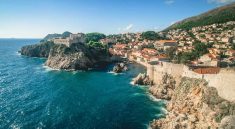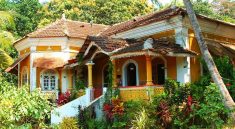The Spanish call it Camino de la Muerte; it’s official name is Yungas Road. It rapidly became one of Bolivia’s most popular tourist attractions. You can’t miss it, they say, it’ll be so much fun. Tourists and backpackers from all around the world and of all ages make it a point to seek out this wildly dangerous road. While you’re visiting temples, sandboarding in the desert, exploring salt flats, and trying all kinds of delicious foods at fun festivals, you’re also supposed to stop at this road. Why?

Death Road – Facts and Background
Yungas Road was originally built by Paraguayan prisoners during the Chaco War in the 1930s. It winds down the slopes of Cordillera Oriental Mountain and used to be the only road that connected La Paz, Bolivia’s colorful capital city, and Coroico. The road is about 43 miles long and offers stunning views of the valley and surrounding mountains.
It was first dubbed “Death Road” when numerous construction workers lost their lives falling off the steep cliffs during the building process. Since then, traveling on this road has ended fatally for hundreds of people – every year. According to estimates, annually about 200-300 people used to fall to their deaths in derailed cars and tumbling busses. In 1995, it was officially established as the most dangerous road in the world.
The road is built right into the mountainside, in certain places it is barely 10 feet wide. Curves are very windy and tight, and extreme weather conditions make a drive on this road a treacherous endeavor. It often snows at the top and clouds frequently surround the mountainsides. Fog and bad weather make it nearly impossible to see what’s ahead. The road itself is a dirt and gravel road, which often gets littered with tumbling rocks or overrun by land- and mudslides. After heavy rains, which happen quite frequently, there can even be small waterfalls right on the roadside. In addition to this being a rather narrow road, there are also hardly any guardrails or other protective measures. The drop is up to 2,500 feet deep in some places, but even the smaller drops are so perilous that not many survive a fall.
Up until 2006, this was the only connection between two major cities, so two-way traffic was constantly navigating this hazardous road. In 2006, a new, different road between these cities was built and Death Road was closed to regular traffic. Since then, it has become a major tourist attraction. The occasional car will still lose its way and end up on this winding mountain street, but most of the time, you will find Death Road full of adventurous bikers, looking for the thrill of racing down this dangerous path.

Death Road Tours
In La Paz, there are companies on every street corner trying to sell tour tickets for this once in a lifetime adventure. Some come here specifically for this, satisfying a morbid but long-time curiosity, others give in to peer pressure. How can you come to La Paz and skip over Death Road?
These mountain biking tours aren’t fool-proof but much safer than driving a car. Only about 1-2 people per year die on this road since it has been closed to through-traffic. Bikers will start at a height of about 15,000 feet, race down the 43 miles, and end at about 3,900 feet. Time and speed obviously depend on the rider, but it is possible to go about 40 mph on certain parts of the road.
The first third of the road is paved – though with lots of potholes and bumps – and it is still open to traffic. This is the part where bikers tend to reach those high speeds; it is also dangerous in its own right though, as bikers have to navigate around other traffic on the road. After right around 13 miles, the actual Death Road starts: an old, rocky, dirt road with lots of sharp winding curves and very steep drops.

The weather can be quite frigid and unpleasant during the first part of the trip down. It is often rainy, windy and cold. Depending on the time of year, there can even be snow. But it gets warmer, the further down you get. That’s why it’s important to bring clothes for any kind of weather: warm layers to shorts and a t-shirt, and actually even a swimsuit. All tours down the mountain end at a hotel with pool access and an extensive buffet. After bracing the cold winds and hanging on to your bike for dear life all day, you will enjoy the relaxing swim in a fancy hotel pool before your shuttle takes you back up the mountain to La Paz.
Other things you should remember to bring along for your ride of a lifetime are sunscreen, bug repellant, and some extra cash – 50 bolivianos for the road tax once you reach the actual Death Road, and more if you are interested in purchasing extra activities along the way. Halfway down there is a zipline, for example, that costs 70 bolivianos and provides a little additional thrill for those who still don’t have enough from the bike tour. Some guides offer the option of going off-roading for a small upcharge. You might also want to pack a reusable water bottle. Some tour companies provide these, while others expect you to bring your own. Be sure to find out before you start your adventure.
Speaking of tour companies, as already mentioned earlier, there are about 30 or more different agencies trying to sell tickets. You will be able to find tickets for extremely different prices, all of them basically offer the same service though: a bike, safety gear, a ride up to the starting point, a guide, pictures along the way, food (including breakfast, snacks and a lunch or dinner buffet), some time at the pool at the end, and a ride back to La Paz.
Why the difference in prices then? Good question! In some cases it truly is a matter of “you get what you pay for”. There are many stories floating around about brakes malfunctioning, bikes breaking down, huge groups with only one guide etc. And some of it is just the typical upcharge and an invitation to negotiate. When you pick a tour company, you should make safety your primary concern. Inquire about their safety procedures, check their website or facebook page for reviews, ask fellow travelers about their experiences.

Gravity Bolivia, or Gravity Assisted Mountain Biking, was the first company to offer these tours. The founder himself ensures safety and very high standards to this day. They have been rated the No. 1 company for bike tours down Death Road for years now. They are not the cheapest, but you can be sure you are in good hands. Another company that has been recommended by backpackers is still fairly new but was started with the intention of offering safer and high quality services, is Bolivian Bike Junkies. If both of these options don’t suit your budget, go shop around and try to negotiate on the streets in La Paz. As you do so, keep in mind that there is always the pitfall of ticket scams, and always make sure that your safety comes first.
Death Road or el Camino de la Muerte can be a great adventure that you will never forget… as long as you are cautious. That starts with picking the right tour company and continues with you being careful on the road. Control your speed, know your limits, be considerate around other bikers, and enjoy the ride. Definitely bring a camera, but only take pictures when you’re stopped. Some backpackers regret not bringing an action camera along, so that is something you might want to consider. Since you will be very focused on the road most of the day, you might enjoy watching a video that captured the scenery for you.
And finally, guides are along for a reason. If you booked your tour with a decent company, your guide will be well-trained and know all the precarious spots as well as the best views and lots of history. Listen to your guide, stick with your group. It’s an adventure, not a race. Make sure that you live to remember. Safety first, fun next, and Death Road can become one of the best things you will ever do in your life. If you want to read some interesting stories about traveling, you should check out Sun-Dried Icicles!




